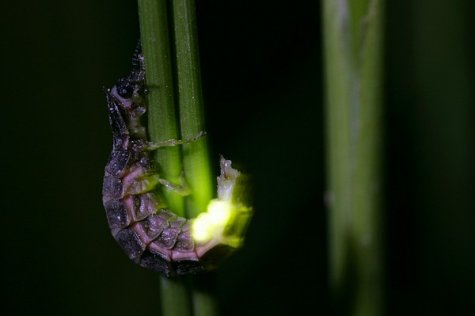Glow-worm and “glow-beetle“
Photos: Arne Ader
Translation: Liis
The half-hour path of a glow-worm on a straw of grass
Glow-worm Jaanimardikas or in common talk jaaniuss Lampyris noctiluca
The females of the glow-worm beetle are wingless and very similar to little worms – visible at Midsummer but also in July. The male beetles have wings in order to find the partners that attract them with their alluring glow more easily. So it is in the glow-worm world.
The glow-worm imagos only live a number of days. During that time they must find a partner, and lay the fertilised eggs to ensure that the glow-worm species continues. In the imago stage the beetles cannot eat; during that time they use up all the accumulated reserves from the pupa stage.
The female beetles glow from the decomposition of a protein named luciferin; the reaction takes place at the tip of the abdomen, under the so-called cuticle, in the photocyte cells. Oxygen is needed for the decomposition of the compound and the amount of oxygen determines the intensity of the glow; the female beetles can regulate the strength of the light. How this is possible – only hypotheses can be read about it.
The light emanating from the decomposition of luciferin is “cold“ and does not contain the infra-red or ultraviolet parts of the spectrum, but it is extraordinarily efficient – 98% of the energy goes to light, the remaining 2% to heat. Sustainable technology has something to ponder on.
Glow-worm light










